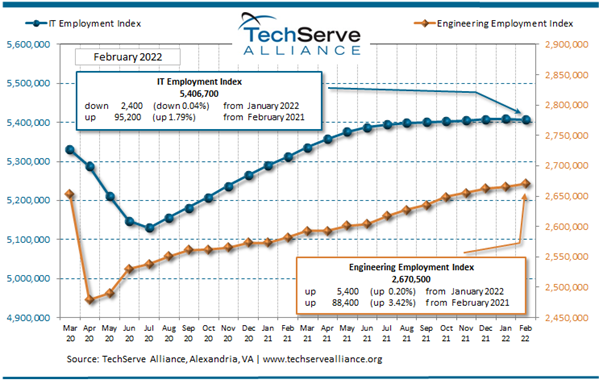The Technical Talent Shortage is at the forefront of employers’ minds—it’s an ongoing impediment to economic growth for the short-term and into the future. The shortage has been amplified by an insufficient number of U.S.-citizen computer science college graduates, restrictive (until recently) and limited H-1B visas for experienced IT professionals to fill the immediate gaps, and now labor market changes pushed by the pandemic.
The good news is that the number of computer science and information science graduates is starting to pick up, according to the National Center for Education Statistics. The number of computer science and information science degrees conferred increased by 124% between 2009-2010 and 2018-2019, from 39,600 to 88,600. However, of the two million bachelors’ degrees conferred in 2018-2019, only 10% were in engineering (6%) and computer science/information services (4%), combined.
Numbers Tell the Story
TechServe Alliance’s most recent monthly IT Employment Index, which closely tracks employment in the technology sector, showed an incremental decline for the first time in more than a year.
“Since emerging from its low ebb brought on by the pandemic, IT employment has been essentially flat for the last seven months. IT employment ticked down modestly for the first time in more than 18 months, reflecting an extraordinarily tight supply of technical talent,” said Mark Roberts, CEO of TechServe Alliance. “It’s up to companies to formulate their talent acquisition strategies that meet the expectations of the talent in terms of compensation and return-to-work policies. Additionally, to be successful in this environment, companies must be creative and diversify their approach to sourcing candidates.”

Several TechServe Alliance member companies, including Signature Consultants and TEKsystems, also report on IT employment trends with a focus on the near-term talent gap and hiring needs. Signature Consultant’s just-issued IT Labor Trends Report Q4 2021 summarizes the situation as “new year, the same story; high demand, low supply will challenge the IT sector.” TEKsystems adds that “with IT jobs projected to grow at a rate of 14%—twice the national rate over the next decade—this isn’t a challenge that is likely to go away. Simply put, the technology talent pipeline is not growing fast enough organically.”
Impact of the Pandemic
In addition to long-existing shortages of IT talent, the pandemic has intensified long-term labor shortfalls. The Bureau of Labor Statistics (BLS) reports on labor trends and in September 2020, BLS published the 2019-29 employment projections. However, the report was later updated in September 2021 to include projections reflecting the potential long-term impact of COVID-19 through 2030. BLS projections reflect long-term analyses of changes which, as the February 2022 BLS Monthly Labor Review states, tend to be gradual. COVID-19 was a “shock” to the U.S. economic system that produced an immediate impact and created a potential for economic changes in long-term trends.
On Sept. 8, 2021, the BLS report showed a widening worker shortage, with 10.9 million available jobs but only 8.7 million available workers. The shortage of workers spanned all industries, but BLS noted that professional and business services and education and health services had worker shortage indexes lower than 0.5, meaning there were double the job openings as unemployed workers.
BLS concluded that “[a]lthough the pandemic’s structural economic impact remains highly uncertain, several factors identified in the alternate pandemic scenarios are likely to persist in the long term. Among these factors is increased remote work, which is likely to affect demand for computer and IT services, as well as food services and business travel.” BLS predicts that many computer occupations will have higher employment levels reflecting the impact of the pandemic with the strongest demand for software developers. The BLS report includes interactive charts projecting future employment trends.
Where Do We Go From Here?
The problem has been identified over and over, but what steps are businesses advocating to resolve the IT worker shortages? Back in June 2021, the U.S. Chamber of Commerce launched its “America Works” campaign to address the worker shortage. At the time, the Chamber suggested a suite of federal and/or state legislative proposals that included training more Americans for in-demand jobs, removing barriers to work (e.g., childcare), doubling the cap on employment-based immigration, and doubling the quota of H-1B and H-2B visas. Business Insider estimated that the U.S. would have about two million more workers if not for restrictive immigration policies under the previous Administration.
In January 2022, during the annual “State of American Business” address, Chamber president Suzanne Clark again urged Congress to double legal immigration. “This workforce shortage is a crisis,” Clark said. “We have to grow our workforce if we want to grow our economy and stay competitive.”
“Let’s [also] ensure everyone in this country has the skills, the education, and the opportunity to go as high and as far as their hard work and talent will take them—for the 11 million jobs that sit vacant today,” she added. “And for the jobs of tomorrow that haven’t even been invented yet.”
Where does this leave the IT and Engineering staffing industry? While more students are pursuing computer science and engineering four-year degrees, a significant number of job openings remain unfilled. Would dropping a four-year degree requirement for certain positions in favor of two-year degrees or even training certificates make sense? As David Moise, CEO of Decide Consulting, noted in a Forbes column, “There are a lot of smart people in the U.S. whose background is not conducive to enrolling in a four-year degree.”
Keeping all these factors in mind, increased technical training, in the long run, and increased numbers of H-1B visas, in the short term, would benefit the technology staffing industry which has grappled with talent shortage for several years.
Up Next: An overview of innovative technical training programs supported by private industry, including staffing firms, and government entities; and legislative and regulatory action to help alleviate the technical talent shortage.












